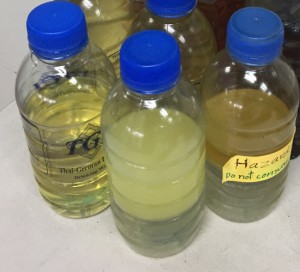
Is there such a thing as wet oil? In the early days of middle school science class, we are taught how water and oil do not mix. You could add pretty much any oil to a beaker of water, and no manner of stirring or swirling could get it to stay mixed for more than a few seconds. If oil and water don’t mix, then why does water cause so much trouble in the hydraulic industry? Why does the industry offer water-removing filter elements, water detecting sensors, desiccant breather caps, etc.?
Water likes to “get up in oil’s business,” by physically entering the reservoir, getting sucked in through rod seals or condensing in dark corners of the hydraulic system. But this type of intrusion isn’t how most of the water in a hydraulic system causes trouble. Don’t get me wrong—free-standing water is bad news. However, free-standing water is usually the result of a catastrophic issue in your machine, such as a missing filler cap, damaged seals or corrosion of the heat exchanger. If you have free water in your hydraulic oil, you are about to spend a lot of time and money to get it cleaned up. But this is still just “water in your oil,” rather than “wet oil.”
On any given day in history, every hydraulic system has water within the oil itself; not little bubbles of water, but rather dissolved into the oil, just like humidity in the air. Most of the time, just as with humidity in air, there are no problems from this damp oil. The machine can run with little or no adverse effect from typical levels of water saturation. Wet oil becomes a problem when water saturation approaches 100%. A saturation level of 100% does not mean that water has entirely replaced the oil in your hydraulic system, but rather, it describes the maximum amount of water that can exist as humidity in the oil before the water separates and forms free water.
It’s nearly impossible to remove all humidity from oil, but it’s always safe to keep saturation levels at less than 50%. Higher levels of saturation can cause breakdown of the oil and its additives, but also puts the steel pumps, valves and actuators of the system at risk of corrosion.
A critical factor in dictating water saturation is temperature. The hotter the oil, the more water is able to be held in solution, just as with a hot, humid day in the summer. If your hydraulic system maintains a consistent ambient and running temperature, the risks of free water forming are low. However, a machine that cycles between high-heat, high ambient humidity conditions and cooler, dryer conditions, will likely see issues related to free water. Every time high humidity oil cools, it can no longer hold the water in saturation, and it can “rain” out of the oil. You can see how this could be a challenge on mobile machinery.
Regardless of the terrible conditions available to some machinery, there isn’t a whole lot that can be done to control wet oil. There are special machines, such as vacuum dehydrators, which can remove saturated water. They operate by heating the oil under vacuum, which lowers the boiling point of the saturated water, and then sucking out the steam and vapor. This can be an expensive piece of machinery, of course, so most fleets will simply use water-removing filter elements. When you employ water-absorbing filter elements to trap free water, consider this important distinction; only free water can be removed from these elements, not humidity. Your best bet is to design a system to prevent as little water intrusion as possible, by providing few points of contact between possible water contamination and your hydraulic oil.

